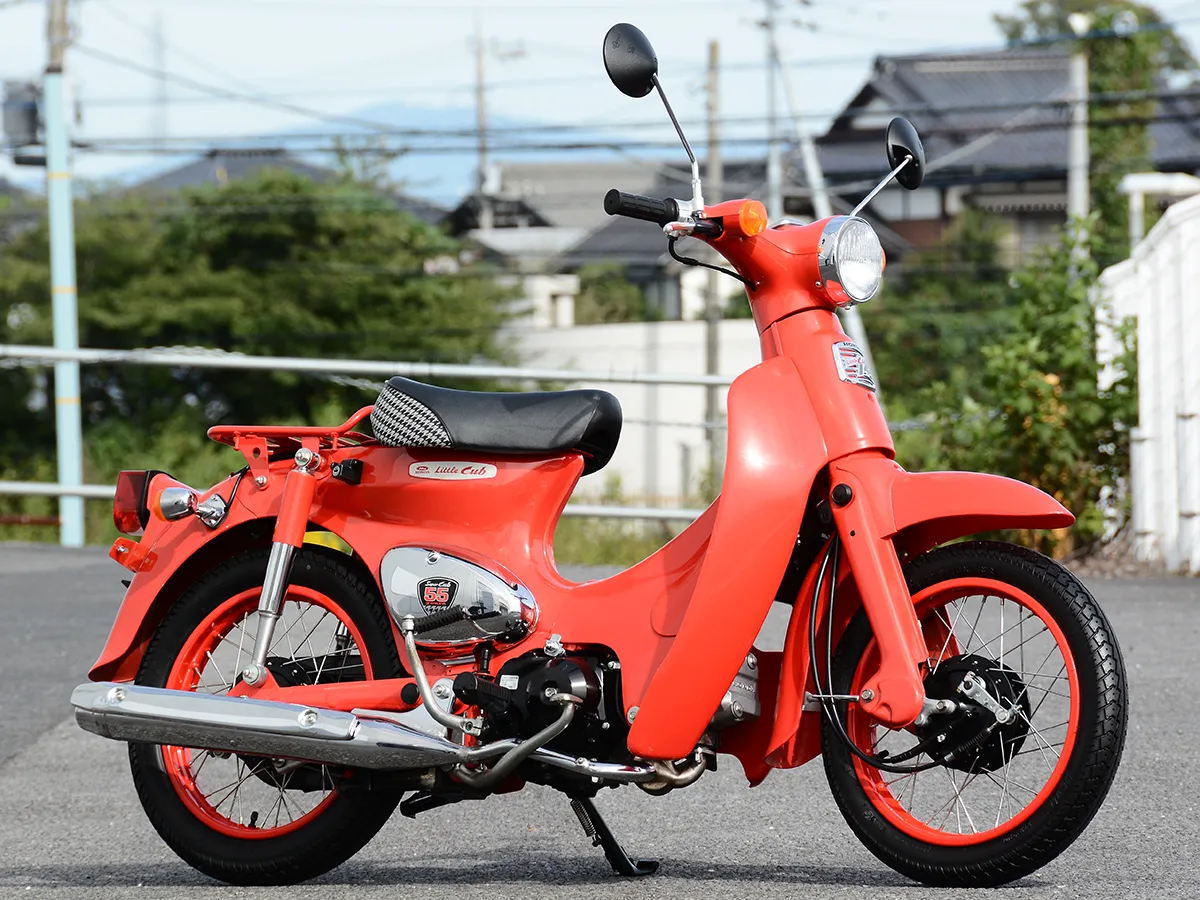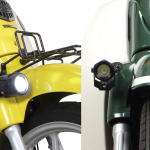It is safe to say that HONDA is what it is today because of one small motorcycle. With its 50cc engine, the motorcycle was given the name "Super Cub" and sold more than 100 million units worldwide. And by 2025, the original 50cc model will be discontinued.
Super Cub = Buckwheat noodle shop motorcycle?
At a time when noodle shops used to deliver noodles to customers on bicycles driven with one hand, Honda ran a Super Cub ad titled “Soba mo genki da okasan” (“Even buckwheat is fine, Mom”) with the theme of a letter to the mother of a young man who comes from the countryside and trains at a Tokyo noodle restaurant. What this means is that “a Super Cub that can be driven with one hand is a motorcycle that can be used for delivery with soba in one hand. In fact, Honda's official records show that during the development stage of the Super Cub, Soichiro Honda said, “This is a motorcycle that can be driven with one hand by a delivery person from a soba restaurant with a buckwheat noodle on his shoulder. It is hard to imagine today, but the traffic rules in the era when the Super Cub was born were much looser than today. The advertisement was a great success, and orders for the Super Cub came in from buckwheat noodle shops and other businesses all over Japan. It was this advertisement that created the image of the Super Cub as the motorcycle for soba shops.
Soichiro Honda and Takeo Fujisawa toured Europe from 1956 to 1957, searching for a motorcycle for the Japanese that was neither a moped nor a scooter. As a result, the two came up with the answers of “something that can be put in one's hand” and “something that is easy to use. They came up with four specific ideas: “a four-stroke engine with high output, quietness, and fuel efficiency,” “a shape and size that would make it easy for women to get on and off,” “a system that would eliminate the need for a clutch lever when operating gears,” and “an advanced design that would be familiar and easy to get used to. The four specific proposals were “an advanced design that would be easy to relate to and not be boring,” according to the company.
The result was the first-generation “Super Cub C100,” equipped with a 50 cc 4-stroke OHV engine that delivered 4.5 PS at 9500 rpm, an overwhelmingly high-revving and high-output for the time, a compact and easy-to-ride design, a 4-speed transmission with an automatic centrifugal clutch that did not require a clutch operation, and a new design with polyethylene The first generation “Super Cub C100” was born, featuring a new design with a leg shield and wing-shaped pressed handlebars.
The Super Cub became a foothold for Honda's entry into the U.S. market and became a beloved motorcycle around the world, spawning many variations. In 2017, the Super Cub set a world record for the production of a single series of motorized mobility vehicles, with 100 million units produced, and production continues to this day.

The first generation “Super Cub C100” was launched in 1958. The engine was an OHV type, and it delivered high performance of 4.5 PS at 9500 rpm.
Little Cub with 14-inch wheels
The model photographed here is the "Little Cub 55th Anniversary Special," which was released in 2013. The Little Cub is a variation of the Super Cub released in 1997, and its most distinctive feature is its 14-inch wheel size. This change in wheel size lowered the seat height from 735 mm to 705 mm, which improved the comfort and ease of getting on and off the motorcycle, as well as its maneuverability.

The Little Cub 55th Anniversary Special, commemorating the 55th anniversary of the C100, was released in 2013 based on the injection version of the Little Cub.

The color of the vehicle photographed is "Fighting Red." The leg guards, carrier, and wheels are the same color as the body, and the side covers are plated.

The other color available, "Black," had black leg guards and carriers and red wheels.
The design followed the basic style of the Super Cub, but the shape of the handlebars, leg shields, front fenders, seat, and rear carrier were changed to give it a more stylish image. The Little Cub was introduced at a time when the Super Cub was gaining popularity as a customization base, and its ease of handling made it a favorite among female owners as well.

Although the vehicle is compact, the position is relaxed and does not feel tight, even for a man of average build.

A 171cm tall, 65kg rider straddles the motorcycle, which has a very good footing thanks to the small diameter 14-inch wheels.
The Little Cub 55th Anniversary Special featured red-painted front and rear rims and black-painted front and rear brake hubs to tighten up the suspension, chrome-finished side covers on both sides, and a sticker commemorating the Super Cub's 55th anniversary. The seat was also fitted with an exclusive lattice pattern design and was available in two colors: Fighting Red and Black.

The handlebars were designed exclusively for the Super Cub, while inheriting its design. The indicator lights are embedded in the handlebars, another Cub-like feature.

Indicator lights are grouped inside a simple speedometer. Instructions for the proper gear are engraved below the speed.

The emblem with "14" for the wheel size is the one used on previous generations of the Little Cub series.

Leg guards designed slimmer than the Super Cub. The leg guards are the same color as the body, giving them a more stylish look.

The seat is an exclusive seat for the 55th Anniversary Special with a lattice pattern. When the seat is flipped up, a fueling port appears underneath.

The rear carrier, an essential part of the Super Cub, is painted in the same color as the body of the 55th Anniversary Special.

Tail light and blinkers mounted on a steel fender. The design stands out for its Cub-like simplicity.

The plated side covers will feature a sticker with a "Super Cub 55" design to commemorate the 55th anniversary.

The high-quality chrome-finished muffler is common to the standard little cub. It produces a pleasant exhaust sound.

It has the traditional bottom-link front suspension specification of the Cub series, with black drum brakes and red-finished wheel rims.

The cover-type rear shock is another traditional part of the Cub series that has been used since the C100 era. The upper side is painted in the same color as the body.

The full-coverage chain case is a unique feature of the Cub series as a practical vehicle.
The eternal standard 50cc Cub
The engine mounted on the Little Cub was basically the same C50E type as the Super Cub, an air-cooled 4-stroke SOHC 2-valve 49cc engine with maximum output of 4.5 PS/7000 rpm and maximum torque of 0.52 kgm/4500 rpm, and the engine start method was kick only. In 1998, a self-starter type was added to the lineup, and in 1999, the carburetor settings were changed to comply with new domestic emission regulations, and a blow-by gas reduction system was adopted. 2007 saw the introduction of an electronically controlled fuel injection system (PGM-FI), and in 2006, a new engine was added to the lineup. In 2007, a minor change was made to comply with the 2006 emission regulations for motorcycles in Japan.

The engine is an air-cooled 4-stroke SOHC 2-valve 49cc with a maximum output of 2.5kW/7000 rpm, maximum torque of 3.8N-m/5000 rpm.

The covers of the engine of the 55th Anniversary Special will be finished in black. The transmission is a return type when the motorcycle is performing and a rotary type only when the motorcycle is stopped.
The Little Cub 55th Anniversary Special has specifications based on the model change in 2007, with maximum output of 2.5 kW (3.4 PS) at 7000 rpm and maximum torque of 3.8 N-m (0.39 kgm) at 5000 rpm, and is equipped with a self-starter. The Little Cub was discontinued in 2017 without complying with the 2016 domestic motorcycle emission regulations, and although all 50cc Super Cubs will finally be discontinued in 2025, it will continue to run with its tough engine in the future.

The first generation Little Cub, model year 1997. It gained great support from young people and expanded the Cub series to a wider range of users.

2007 model with injection; production continued based on this specification until 2017.

Launched in 2015 to commemorate the Super Cub's three-dimensional trademark registration, the Little Cub Special features an exclusive body color, Pearl Coral Reef Blue, and exclusive emblems.

The "Super Cub 50 Final Edition" was released with a limited order of 2,000 units, but orders for more than 10,000 units have been received, and Honda has announced that it will produce the entire order.
Little Cub 55th Anniversary Special Main Specifications (2013)
Overall Length x Width x Height: 1775 x 660 x 960 mm
Wheelbase: 1190mm
Seat Height: 705mm
Vehicle Weight: 81kg
Engine: Air-cooled 4-stroke SOHC 2-valve single cylinder 49cc
Maximum Output: 2.5kW (3.4PS)/7000rpm
Maximum Torque: 3.8N・m (0.39kgm)/5000rpm
Transmission: 4-speed return (mechanism that is returnable while driving and rotary only when the vehicle is stopped)
Fuel Tank Capacity: 3.4L
Brakes: F=drum, R=drum
Tire: F=2.50-14, R=2.75-14
Price: (Reference Price: JPY249,900) around PHP94,000 (price at that time including tax)
Photo Credits: Bike-Oh Tsukuba Discontinued Museum

The showroom is stocked with discontinued models of all genres. The showroom is stocked with a large number of motorcycles in different colors, so you are sure to find one to your liking.
Original Source [ Webike JP Website ]
See HONDA Moto Index Page
See HONDA SUPER CUB C100 Parts & Accessories Page



